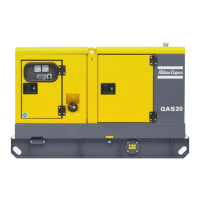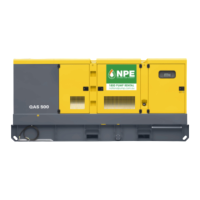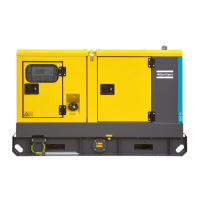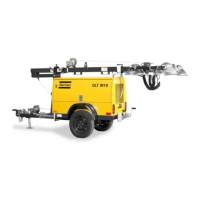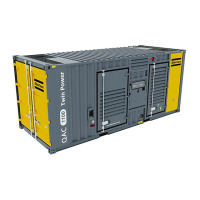
Do you have a question about the Atlas Copco QAC 1100 Sd and is the answer not in the manual?
| Model | QAC 1100 Sd |
|---|---|
| Frequency | 50 Hz |
| Noise Level | 75 dB(A) at 7m |
| Voltage | 400 V |
| Engine | Scania |
| Power Output | 1100 kVA / 880 kW |
Defines warranty duration based on sales invoice or technical delivery.
Lists conditions under which the warranty becomes void.
Outlines who bears transportation and related costs for warranty services.
Emphasizes using authorized parts and written approval for modifications.
States Atlas Copco's responsibility for potential mistakes in the manual.
Policy on voltage changes during technical delivery and customer responsibilities.
Process for requesting and performing voltage changes after the initial delivery.
Instructions for adjusting voltage and frequency using the AVR, including E1/E2 settings.
Details the feeding of the leakage current to earth relay with 220V.
Discusses potential risks associated with voltage and current changes, including circuit breaker issues and AVR calibration.
Outlines Atlas Copco's commitment to safety and key factors considered.
Defines four levels of expertise required for operating and maintaining the equipment.
Presents special safety guidelines and precautions applicable to Atlas Copco equipment.
Details the potential dangers to persons, environment, and machines from ignoring safety precautions.
Outlines owner/supervisor duties and machine maintenance for safe operation.
Covers overheating, correct usage, cleaning, and work area safety.
Details fire prevention, handling flammable substances, and appropriate extinguisher types.
Emphasizes proper grounding and the inspection/compliance of safety devices and markings.
Covers safe practices for lifting, securing, and handling the generator during transport.
Details requirements for generator placement, ensuring adequate space and ventilation.
Specifies compliance with wiring codes and pre-connection checks for load and generator specifications.
Covers fire prevention, exhaust gas handling, air intake, and cooling system safety.
Details safe fueling, regular maintenance, and the importance of fixed guards.
Addresses noise exposure mitigation and precautions when handling hot components.
Emphasizes safety shoes, helmets, and protective gear for respiratory and skin hazards.
Covers safe operation in dusty/humid environments and electrical terminal safety.
Details actions for strange situations, cable checks, and avoiding overloading.
Outlines procedures for maintenance, tool usage, machine shutdown, and securing components.
Covers safe cleaning practices, chemical handling, and preserving sound insulation.
Details correct lubricant use, safety during heat operations, and machine support.
Specifies checks after repairs and proper disposal of fluids to prevent pollution.
Emphasizes using the correct tools and understanding their limitations to prevent accidents.
Covers electrolyte hazards, charging area safety, explosive gas risks, and proper charging procedures.
Introduces the QAC 1100 Sd as an AC generator for backup and continuous operation.
Provides a diagram and list identifying the key components of the generator set.
Describes the soundproof frame containing the generator's main systems.
Explains various labels indicating hazards, operational instructions, and component information.
Identifies the location of engine oil, coolant, and fuel drain plugs on the generator frame.
Explains the function of the drain hole for external fuel container connections.
Describes how to access the engine coolant filler plug and the location of the fuel filler plug.
Details the control module's role in generator operation, protection, and communication.
Describes the output terminal panel and key components like the emergency stop, relays, and circuit breakers.
Discusses dual frequency capability and voltage adjustment via R12 potentiometer.
Explains the location and function of the battery switch and its safety warning.
Guides on starting, operating, checking, and shutting down the generator.
Explains the process of setting up the module, including mode selection.
Details the function of each pushbutton for controlling and navigating the generator's interface.
Explains the meaning of various indicator lights on the generator, showing status like alarms, power, and run.
Describes the indicator lights on the main control unit, including power, self-check, and CAN network activity.
Describes the different screen views (Main, V1, V2, V3) and their displayed information.
Explains how to access and program protection and control parameters via the setup menu.
Explains various protective parameters like Set Point, Delay, and Output relay configurations.
Details password levels, parameter modification procedures, and using the JUMP button.
Illustrates the menu sequence for Control, I/O, and System Setup configurations.
Directs users to the Qc4002™ MkII User Manual for comprehensive setup information.
Explains the different password levels and how they affect parameter access and modification.
Describes the various running modes available for the generator and their operational characteristics.
Explains the purpose and operation of the block mode, used for maintenance or preventing unintended starts.
Details the Island operation and Auto Mains Failure (AMF) applications, including their mode requirements.
Details AMF, PS, and FP modes for mains failure backup and load management.
Explains MPE for power export and LTO for load transfer between mains and generator.
Describes the TM mode for maintenance operations on transformers.
Explains the PMS for automatic generator start/stop based on load, and parameter programming.
Details communication methods and shielded CAN cable requirements for PMS in parallel operation.
Outlines necessary connections for parallel running and safety checks, like disabling the Ground Leakage Relay.
Lists and describes various applications (Island, AMF, Peak Distribution, etc.) for single generator installations.
Details applications for multiple generators, including Island, AMF, and PMS configurations.
Explains PMS functionality and critical parameters for multi-generator installations.
Stresses adherence to safety instructions, technical limits, and specific system precautions.
Provides guidelines for generator installation, door closure, ventilation, and maintenance space.
Details generator grounding, connection to the power system, and precautions for non-linear loads.
Covers cable quality, sectional area, length, and voltage drop calculation for safe connections.
Details protection requirements for load circuits and step-by-step procedures for connecting loads.
Ensures correct engine oil, coolant, and fuel levels, and checks fuel pre-filter status.
Verifies air filter, checks for leaks, and confirms safety systems (emergency stop, circuit breakers, ground fault) are ready.
Outlines essential safety checks before commencing any maintenance operations.
Details routine maintenance tasks for the alternator, including cleaning and voltage checks.
Lists essential engine maintenance tasks, such as oil level checks and fluid replacements.
Covers maintenance for engine coolant, unit general condition, fluid levels, and cleaning.
Provides notes on maintenance frequency based on environment and warns against improper biodiesel usage.
Details the procedure and requirements for measuring alternator insulation resistance.
Refers to Atlas Copco recommendations for engine fuel and oil, including PAROIL lubricant details.
Highlights PAROIL lubricant's features, performance benefits, and protection qualities.
Provides guidance on checking engine oil levels and refers to maintenance charts for oil change procedures.
Details safety precautions for handling hot coolant and recommends specific Atlas Copco coolant fluids.
Describes PARCOOL EG coolant's features, benefits, and environmental considerations.
Explains methods for checking coolant condition: visual, pH, and glycol concentration.
Details the steps for draining, washing, and refilling the engine coolant system.
Provides guidelines for storing the generator in a dry, ventilated environment and periodic engine running.
Outlines procedures for preparing the generator after storage, including inspections and running tests.
Addresses issues with zero voltage output from the alternator, including causes and corrective actions.
Covers troubleshooting for low/high no-load voltage and voltage variations under load.
Addresses issues with slow starter motor operation and engine starting difficulties.
Covers problems like poor power output, black exhaust smoke, and high fuel consumption.
Addresses issues related to exhaust smoke color and unexpected engine shutdowns.
Covers troubleshooting for improper engine running, vibration, oil pressure, and sump pressure.
Addresses bad compression, intermittent starting/stopping, and engines switching off shortly after starting.
References the circuit diagrams for the Qc4002 unit, including complete circuit information.
Lists optional features for the QAC 1100 Sd units, such as spark arrestors and earth leakage relays.
Explains the operation, voltage adjustment, and features of the automatic battery charger.
Describes the function of the coolant fluid heater for improving engine startability.
Explains the purpose of optional items like spark arrestors, ground leakage relays, and the Qc4002™ controller.
Specifies the readings for ammeter and voltmeter indicators.
Lists functions and actuation points for switches related to engine oil pressure and coolant temperature.
Presents key technical specifications for the generator at 60Hz and 50Hz under reference conditions.
Outlines limitations related to ambient temperature, altitude, humidity, and starting temperature.
Provides detailed application data including rated power, voltage, current, and performance classes.
Details running modes, site conditions, and environmental exposure for generator applications.
Presents design specifications for the alternator (manufacturer, model) and engine (standard, type, model, power).
Lists engine specifications like cylinder capacity, cooling system, and electrical system details.
Provides technical data for circuit breakers at different voltages and protection against current faults.
Provides conversion factors for various SI units to their British equivalents.
Lists recommended tightening torque values for different screw and nut sizes.
Explains the various fields found on the generator's data plate.
Provides detailed dimensions, center of gravity, and maintenance space requirements for the generator.
Lists the wet and dry mass for the QAC 1100 model.

